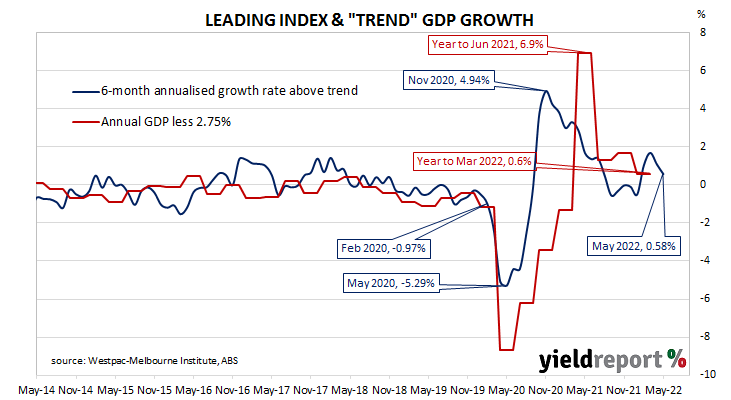Summary: Westpac-MI Leading index growth rate down in May; shock to consumer confidence an emerging theme; reading implies annual GDP growth of around 3.00% to 3.25%; Westpac expects below-trend growth later in 2022, 2023.
Westpac and the Melbourne Institute describe their Leading Index as a composite measure which attempts to estimate the likely pace of Australian economic growth in the short-term. After reaching a peak in early 2018, the index trended lower through 2018 and 2019 before plunging to recessionary levels in the second quarter of 2020. Subsequent readings were markedly higher but readings through 2021 mostly declined.
The May reading of the six month annualised growth rate of the indicator registered 0.58%, down from April’s revised figure of 1.09%.
“The components of the Index are indicating an important emerging theme around Australia’s growth prospects – a significant shock to consumer confidence,” said Westpac Chief Economist Bill Evans. However, he noted the current reading “is still indicating above-trend growth momentum heading into the three-to-nine month ‘window’.“
Index figures represent rates relative to “trend” GDP growth, which is generally thought to be around 2.75% per annum in Australia. The index is said to lead GDP by “three to nine months into the future” but the highest correlation between the index and actual GDP figures occurs with a three-month lead. The current reading thus represents an annual GDP growth rate of around 3.00% to 3.25% in the September quarter.
Domestic Treasury bond yields moved considerably lower on the day. By the close of business, the 3-year ACGB yield had shed 10bps to 3.75%, the 10-year yield had lost 8bps to 4.06% while the 20-year yield finished 10bps lower at 4.21%.
In the cash futures market, expectations for the path of the actual cash rate over time were pulled back. At the end of the day, contracts implied the cash rate would rise from the current rate of 0.81% to 1.20% in July and then increase to 1.73% by August. November contracts implied a 2.995% cash rate while May 2023 contracts implied 3.97%.
“The slump in Consumer Sentiment, under the weight of rising interest rates and falling house prices, is likely to take its toll on spending later in the year and into 2023,” said Evans. “We expect this to see the growth rate in the economy fall below trend and should be foreshadowed by negative reads for the Leading Index growth rate later this year.”


